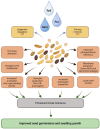Polyamine Seed Priming: A Way to Enhance Stress Tolerance in Plants
- PMID: 39684300
- PMCID: PMC11641681
- DOI: 10.3390/ijms252312588
Polyamine Seed Priming: A Way to Enhance Stress Tolerance in Plants
Abstract
Polyamines (PAs), such as putrescine, spermine, and spermidine, are bioactive molecules that play a vital role in plant responses to stresses. Although they are frequently applied to achieve higher levels of stress tolerance in plants, their function in seed biology is still not fully understood. PAs have been described in only a limited number of studies as seed priming agents, but most of the data report only the physiological and biochemical PA effects, and only a few reports concern the molecular mechanisms. In this review, we summarized PA seed priming effects on germination, seedling establishment, and young plant response to abiotic stresses, and tried to draw a general scheme of PA action during early developmental plant stages.
Keywords: abiotic stress; chilling stress; priming memory; rice (Oryza sativa L.); salt stress; seed biology; seed germination.
Conflict of interest statement
The authors declare no conflicts of interest.
Figures


References
-
- Di Girolamo G., Barbanti L. Treatment Conditions and Biochemical Processes Influencing Seed Priming Effectiveness. Ital. J. Agron. 2012;7:25. doi: 10.4081/ija.2012.e25. - DOI
-
- Lutts S., Benincasa P., Wojtyla L., Kubala S., Pace R., Lechowska K., Quinet M., Garnczarska M. Seed Priming: New Comprehensive Approaches for an Old Empirical Technique. In: Araujo S., Balestrazzi A., editors. New Challenges in Seed Biology—Basic and Translational Research Driving Seed Technology. InTech; Houston, TX, USA: 2016. - DOI
Publication types
MeSH terms
Substances
LinkOut - more resources
Full Text Sources

